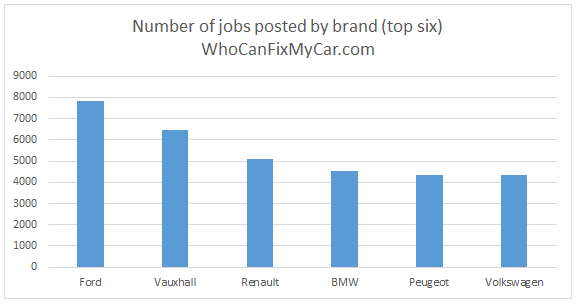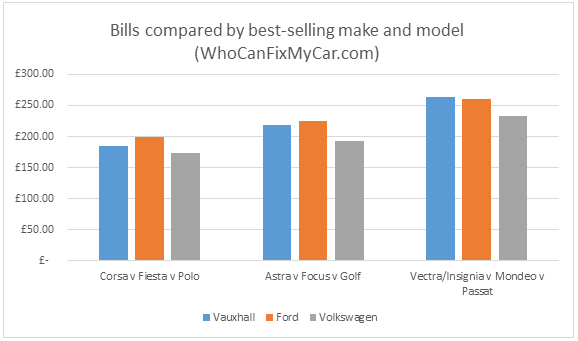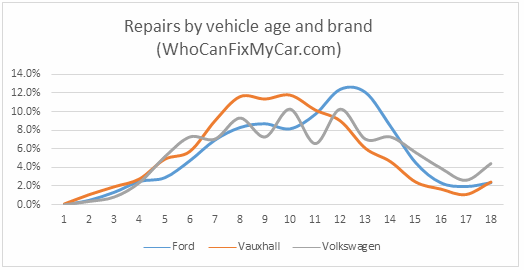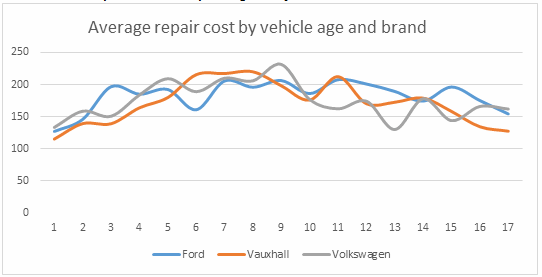In the second of a regular series, WhoCanFixMayCar.com (WCFMC) compares the repair costs of three of the best selling brands in the UK: Ford, Vauxhall and Volkswagen.
Almost 50,000 drivers have used WCFMC to find a garage to service or repair their vehicle. Using the data gathered, it compares maintenance costs across the three brand's best-selling models - and how these costs change as cars get older.
The data
1. Repair costs by brand

18,608 separate jobs have been analysed to produce the following data.

From WCFMC.com's analysis, two trends are clear.
First, bills vary drastically by repair type.
Transmission work, for example, comes in at a full 107% pricier than a typical servicing bill.
Secondly, the brands themselves are comparable overall, with just a 10% difference between dearest (Ford) and cheapest (Volkswagen).
Model analysis
2. Maintenance bills by best-selling model

It’s clear that while estimates by brand are similar, there’s a significant trend: the larger the car, the higher the average cost - 36% higher for a large family car than a supermini, to be precise. But why?
3. What causes the 36% difference in bills between large and small cars?
Sticking with our nine bestsellers, WCFMC wanted to understand what type of work would cause such a discrepancy. It stripped out non-essential repairs, such as radio upgrades and valeting, to find out.

Pricing is consistently higher across all categories except ‘engine and cooling’ - a collection of under-the-bonnet repairs for which complexity changes little by vehicle.
However, across transmission, brakes and exhausts, electrical work and servicing, the trend is clear: bigger car equals bigger costs.
Transmission work is 68% more expensive for Mondeo-sized cars compared to their Fiesta-sized equivalents. More expensive parts, more complex vehicles and the higher likelihood of pricy automatic gearbox work all contribute to the difference.
4. Middle-aged cars, middle-aged problems...

The likelihood of repairs at a certain age does vary by brand.
Owners of Vauxhalls are most likely to book in when the car is eight-10 years old, with Ford drivers turning to WCFMC.com two-three years later.
Repair work in much older cars (15+ yrs) is always less common, with fewer of these vehicles on the road and fewer miles covered, but Volkswagens do conform to the stereotype of longevity - with more of them being regularly maintained via WhoCanFixMyCar.com at that age.
5 ... with repair estimates peaking for nine-year-old cars

Repair frequency is good to know, but means little without knowing how much the work is actually going to cost.
So WCFMC.com also looked at the typical estimates quoted, again split by vehicle age.
Costs steadily rise to peak at eight-nine years old, as these cars require substantial ‘middle-aged’ maintenance (new clutches, cambelts etc).
However, from that point on, typical bills actually decline.
Vehicles cover fewer miles, and certain faults may be tolerated by their drivers. Plus older models are often simpler to work on, thus requiring less labour time, reducing estimates.
Conclusion
Alex Rose, WCFMC marketing director, said: "The outcome is clear. On average, and perhaps surprisingly, typical costs are a little lower for VW models than they are for Ford and Vauxhall.
"But this difference is insignificant when comparing across vehicle sizes: larger models are 36% more expensive to maintain than their smaller stablemates, across almost all repair types.
"Finally, as cars reach ‘middle age’, not only does repair frequency increase, but average repair estimates do too.
"So, according to our data, a 10-year-old supermini will probably cost more to maintain than a five-year-old large saloon car."
For queries on the data contact Rose at alex@whocanfixmycar.com.
Next time: WCFMC will look more at ‘vehicle ageing’ to understand when specific repair types tend to take place, and what they will cost.
Related:
















Login to comment
Comments
No comments have been made yet.